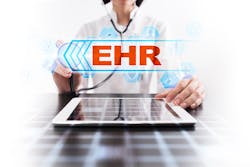There are an estimated 84 million people in the United States living with prediabetes (higher-than-normal blood sugar level). The National Diabetes Prevention Program (DPP) has proven effective at coaching people to make lifestyle changes. Yet making referrals to DPP a regular part of clinical workflow has proven challenging. The American Medical Association, the Henry Ford Health System and Epic Systems have worked together on EHR optimization to improve the referral process.
In a June 26 presentation in Thomas Jefferson University’s “PopTalk” series, Kate Kirley, M.D., director of chronic disease prevention in the Improving Health Outcomes group at the AMA, described the effort at Henry Ford. Kirley, who serves as the lead clinician on the AMA’s diabetes prevention initiatives, began by noting that the DPP lifestyle coaching program method developed by the Centers for Disease Control and Prevention (CDC has been shown to reduce the incidence of type 2 diabetes by 58 percent compared to placebo.
Prior to joining the AMA, Kirley was a practicing family physician and health services researcher at NorthShore University HealthSystem, and a clinical assistant professor in the Department of Family Medicine at the University of Chicago. She says most primary care doctors are not yet screening patients for prediabetes in ways that are consistent with guidelines and are missing people who should be screened. Research suggests that fewer than 23 percent have ever made referrals to DPP, she said. “The role of physicians is to identify at-risk patients, document it in the EHR and tell their patients, then engage them in shared decision making about their treatment options, and then support them,” she says.
The AMA is working with healthcare systems and physician practices on their diabetes prevention strategies, including improving systematic screening and referral to DPP and also looking at where technology can support prevention, including EHR optimization and digital and mobile health solutions, she said
Kirley described a year-long effort working in partnership with Henry Ford Health System, a Michigan-based integrated health system, to optimize their instance of Epic to support clinical processes. This included adding some clinical decision support features, solutions to support patient engagement and bidirectional e-referrals to DPP.
Traditionally, she said, patient education about DPP had gone through a faith and community health unit. It had been recruiting people from the community, but the DPPs had been receiving minimal physician referrals. “We have seen this elsewhere,” Kirley said. The outreach efforts are often located in the community health and benefit arm of the organizations, which are not well connected to clinical side. At Henry Ford, the clinical side wanted to shore up its screening and management of prediabetes.
The AMA worked with the clinical teams to lay out the clinical processes, then worked with Epic to optimize those processes. “Epic was a great partner, because they also want to improve their own functionality around diabetes screening,” she adds. “We started with what is supposed to happen on the clinical side — who needs to do what on the care team to deliver guideline-consistent care.”
Epic helped Henry Ford create advisories to prompt clinicians that a patient was due for a lab test or had elevated risk factors. A second advisory would tell the clinician that the patient likely had prediabetes and to document that and order DPP. They created clinical order sets and prompts to order. They also created registry tools for prediabetes, with standard reports to identify populations they might want to intervene with. They also created tools to do bulk ordering of lab tests and bulk referrals to DPP and bulk patient messaging. They also built a prediabetes risk screener into the patient portal.
The team also worked on ways to send referrals to DPP and to close the loop by having the DPPs send information back to clinicians about patient participation and outcomes.
Although they spent a fair amount of time in development, once Henry Ford introduced the new functionality in Epic to 36 providers, they were fairly hands off. Over a year, they identified 4,686 people with possible prediabetes through the portal screener or a lab test.
The DPP programs that if they try to refer all of those people, it would be like drinking from a firehose and that they would just be inundated, Kirley said. They chose to focus on people coming in for a routine visit and offer referrals to DPP. They ended up offering to 297 people or. 6.3 percent of those eligible. “That number may not sound like much, but actually it is incredible,” she said. “The baseline was close to zero. Going from nothing to 6.3 percent referred is remarkable.”
A little over 200 enrolled, which is also really high. “We have seen conversion rates in around the 10 percent to 20 percent range,” she said. “Seeing two-thirds is fantastic. That was one year of turning on the technology and seeing what happens.”
Another interesting thing they noticed is that the average weight loss outcomes for DPP improved. “Their average weight loss was under 5 percent before, but once they started receiving referrals from the clinical side, outcomes improved,” she said. “It suggests that there is something about clinicians being involved in making the referral that is making a difference.”
In the year since the study, Henry Ford has started new DPP programs to keep up with demand. All 36 providers involved in the study engaged with the functionality and made referrals. “What is really exciting was that after the study period, more than 80 providers have started using the functionality in the EHR without being formally introduced to them. “It seems like what we were able to do in the EHR has taken on a life of its own,” she says, “and that is what we wanted to see.”
Kirley noted that bidirectional referral has proved challenging. By bidirectional, she means the DPP receives a referral, gets the patient enrolled and then sends feedback back to the clinician electronically. “It is a tricky issue to solve,” she said. It is easier if the physician’s office only refers to one DPP, but if you have a number of options in your area, it starts to become complicated to make electronic referrals. She said the AMA is considering solutions such as Aunt Bertha, Unite Us and NowPow, which are creating networks of community resources to deal with a number of issues related to social determinants of health such as housing and transportation. AMA is looking at how they can support bidirectional referrals to DPP.
Finally, Kirley mentioned that AMA is developing a set of electronic clinical quality measures. “There have been none in the diabetes prevention space, so it has been difficult for healthcare systems to track and understand how they are performing,” she said. Its three eCQMs involve screening, management and monitoring of patients with prediabetes.


